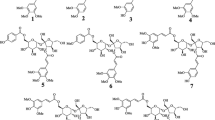Abstract
A phytochemical study for the MeOH extract of Annona squamosa leaves led to the isolation of seven compounds. Among them there were two nitro derivative compounds (1 and 2), two phenolic glucoside compounds (3 and 4), and three sesquiterpenes (5‒7). The structures of these natural compounds were determined by the spectroscopic methods including 1D and 2D NMR methods. All the isolated compounds were assessed for the effects on the sEH inhibitory activity; of all the compounds, thalictoside (1) and arabinothalictoside (2) displayed strong inhibition of sEH activities with IC50 value of 20.2 µM and 47.1 µM, respectively. A kinetic analysis of compounds 1 and 2 revealed that both of them were competitive inhibitory action. The molecular docking increases our understanding of receptor‒ligand binding of all compounds. These results suggested that nitro derivatives from Annona squamosa leaves are potential sEH inhibitors.



Similar content being viewed by others
References
Bai MM, Shi W, Tian JM et al. (2015) Soluble epoxide hydrolase inhibitory and anti-inflammatory components from the leaves of Eucommia ulmoides Oliver (Duzhong). J Agric Food Chem 63:2198–2205
Campbell WB, Gebremedhin D, Pratt PF et al. (1996) Identification of epoxyeicosatrienoic acids as endothelium-derived hyperpolarizing factors. Circ Res 78:415–423
Cleland WW (1963) The kinetics of enzyme-catalyzed reactions with two or more substrates or products: III. Prediction of initial velocity and inhibition patterns by inspection. Biochim Biophys Acta 67:188–196
Hisamoto M, Kikuzaki H, Nakatani N (2004) Constituents of the leaves of Peucedanum japonicum Thunb and their biological activity. J Agric Food Chem 52:445–450
Imig JD, Hammock BD (2009) Soluble epoxide hydrolase as a therapeutic target for cardiovascular diseases. Nat Rev Drug Discov 8:794
Kaleem M, Asif M, Ahmed QU et al. (2006) Antidiabetic and antioxidant activity of Annona squamosa extract in streptozotocin-induced diabetic rats. Singap Med J 47:670–675
Kaleem M, Medha P, Ahmed QU et al. (2008) Beneficial effects of Annona squamosa extract in streptozotocin-induced diabetic rats. Singap Med J 49:800
Kim GS, Zeng L, Alali F et al. (1998) Muricoreacin and murihexocin C, mono-tetrahydrofuran acetogenins, from the leaves of annona muricata in honour of professor GH Neil Towers 75th birthday. Phytochemistry 49:565–571
Kim JH, Ryu YB, Lee WS et al. (2014) Neuraminidase inhibitory activities of quaternary isoquinoline alkaloids from Corydalis turtschaninovii rhizome. Bioorg Med Chem 22:6047–6052
Mazahery ARF, Dator RP, Concepcion GP et al. (2009) Murihexocin C from the leaves of Annona squamosa Linn. induces apoptosis in human colon carcinoma Col 2 cell line. Philos Agric Sci 92:122–132
Ma C, Chen Y, Chen J et al. (2017) A review on Annona squamosa L.: phytochemicals and biological activities. Am J Chin Med 45:933–964
Morita H, Iizuka T, Choo CY et al. (2006) Vasorelaxant activity of cyclic peptide, cyclosquamosin B, from Annona squamosa. Bioorg Med Chem Lett 16:4609–4611
Panda S, Kar A (2015) Protective effects of 5, 7, 4′-trihydroxy-6, 3′ dimethoxy-flavone 5-O-α-l-rhamnopyranoside, isolated from Annona squamosa leaves in thyrotoxicosis and in hepatic lipid peroxidation in rats. Bioorg Med Chem Lett 25:5726–5728
Soni VK, Yadav DK, Bano N et al. (2012) N-methyl-6, 7-dimethoxyisoquinolone in Annona squamosa twigs is the major immune modifier to elicit polarized Th1 immune response in BALB/c mice. Fitoterapia 83:110–116
Tran L, Kompa AR, Wang BH et al. (2012) Evaluation of the effects of urotensin II and soluble epoxide hydrolase inhibitor on skin microvessel tone in healthy controls and heart failure patients. Cardiovasc Ther 30:295–300
Wagner KM, McReynolds CB, Schmidt WK et al. (2017) Soluble epoxide hydrolase as a therapeutic target for pain, inflammatory and neurodegenerative diseases. Pharm Ther 180:62–76
Wang HM, Kao CL, Liu CM et al. (2017) Chemical constituents of the roots of Pluchea indica. Chem Nat Compd 53:736–737
Wang J, Shen Y, He H et al. (2005) Norsesquiterpenoid and sesquiterpenoid glycosides from Evodia austrosinensis. Planta Med 71:96–98
Xu F, Ding Y, Guo Y et al. (2016) Anti-osteoporosis effect of Epimedium via an estrogen-like mechanism based on a system-level approach. J Ethnopharmacol 177:148–160
Yoshikawa M, Yoshizumi S, Murakami T et al. (1996) Medicinal foodstuffs. II. On the bioactive constituents of the tuber of Sagittaria trifolia L. (Kuwai, Alismataceae): absolute stereostructures of trifoliones A, B, C, and D, sagittariosides a and b, and arabinothalictoside. Chem Pharm Bull 44:492–499
Zarriello S, Tuazon J, Corey S et al. (2019) Humble beginnings with big goals: small molecule soluble epoxide hydrolase inhibitors for treating CNS disorders. Prog Neurobiol 172:23–39
Zeng Q, Chang R, Qin J et al. (2011) New glycosides from Dracocephalum tanguticum maxim. Arch Pharmacal Res 34:2015–2020
Acknowledgements
This research was supported by a grant [KSN1812160] awarded to Korean Institute of Oriental Medicine by the Ministry of Education, Science, and Technology (MEST), Republic of Korea.
Author information
Authors and Affiliations
Corresponding authors
Ethics declarations
Conflict of interest
The authors declare that they have no conflict of interest.
Additional information
Publisher’s note: Springer Nature remains neutral with regard to jurisdictional claims in published maps and institutional affiliations.
These authors contributed equally: Hong Xu Li, Seo Young Yang
Supplementary information
Rights and permissions
About this article
Cite this article
Li, H.X., Yang, S.Y., Kim, Y.S. et al. Nitro derivatives and other compounds from sugar apple (Annona squamosa L.) leaves exhibit soluble epoxide hydrolase inhibitory activity. Med Chem Res 28, 1939–1944 (2019). https://doi.org/10.1007/s00044-019-02425-2
Received:
Accepted:
Published:
Issue Date:
DOI: https://doi.org/10.1007/s00044-019-02425-2




